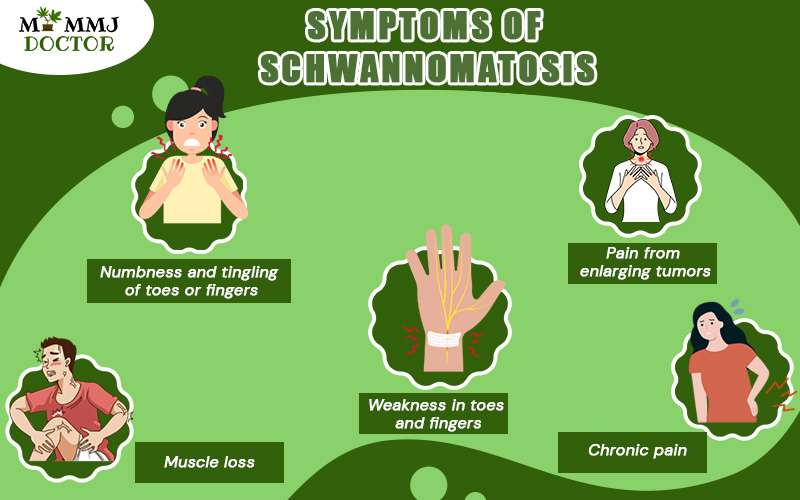Neurofibromatosis: Types, Symptoms, Causes and its Treatment with Cannabis!

Neurofibromatosis (NF) is a type of syndrome and a rare genetic disorder that results in benign tumours (non-cancerous) on the nervous tissue. These tumours can develop anywhere in the nervous system including nerves, brain, and spinal cord. Along with that, it might also manifest in other parts of the body including the skin.
Primarily, Neurofibromatosis disorder affects the development of nerve cell tissue.
This genetic disorders include two types of neurofibromatosis including:-
- Neurofibromatosis type 1 (NF1)
- Neurofibromatosis type 2 (NF2)
Schwannomatosis has also recently been recognized as the rarest and third type of Neurofibromatosis, but there is less information about it.
NF1
NF1 is the most common type of Neurofibromatosis. It is also known as Recklinghausen disease, which causes multiple tan patches or light brown skin and neurofibromas which are the fleshy growths on or under the skin.
It can also lead to deformed or enlarged bones and spine curvature. Occasionally the tumors may develop in the brain, spinal cord, or cranial nerves.
Around 50 to 75 percent of people with NF1 also experience learning disabilities.
NF1 Symptoms
The common symptoms of NF1 include:
- Many Cafés au lait spots
- Tiny growth in the iris of the eye
- Multiple freckles in the groin area or armpit
- NF occurs on or under the skin
- Tumors along the optic nerve that may lead to eyesight issues
- Bone deformities
- Nerve related pains
- Osteoporosis
- High blood pressure
- Learning disabilities
- Short stature
- Large head size
NF2
NF2, also known as bilateral acoustic Neurofibromatosis, is much less common than the first type and is often characterized by multiple tumors on the spinal and cranial nerves.
NF2 Symptoms
People with NF2 experience the below-mentioned symptoms
- Hearing loss
- Face muscle weakness
- Poor balance
- Dizziness
- Uncoordinated walking
- Cataracts
- Headaches

Schwannomatosis
This results in the development of multiple tumors, known as schwannomas, which grow on the protective coverings of peripheral nerves across the body, often resulting in severe pain and neurological impairment.
Symptoms of Schwannomatosis
- Numbness and tingling of toes or fingers
- Pain from enlarging tumors
- Chronic pain
- Muscle loss
- Weakness in toes and fingers
Causes of Neurofibromatosis!
The disease is often inherited, but it is also true that around 50 percent of the people newly diagnosed with the health condition have no family history of the disease.
This is because it can also be due to gene mutations. Once this modification takes place, one can pass the mutant gene on to future generations.
Cause of NF1
The NF1 gene on chromosome 17 makes a protein known as neurofibromin that controls the development of cells. The mutation of this gene leads to uncontrolled cell development and neurofibromin loss.
Cause of NF2
The NF2 gene on chromosome 22 makes a protein known as schwannoma or merlin that suppresses tumors. The modifications in this gene lead to merlin loss and uncontrolled cell development.
Cause of Schwannomatosis!
The mutations of two genes associated with schwannomatosis, LZTR1, and SMARCB1, suppress the tumors linked with this type of Neurofibromatosis.
Diagnosis of Neurofibromatosis!
The diagnosis of Neurofibromatosis involves several tests. This includes:
- Medical history
- Physical examination
- X-rays
- Family history
- CT scans
- MRI
- Neurofibromas Biopsy
- Eye tests
- Genetic Testing
- Tests for specific symptoms
To verify the diagnosis of NF1, a person must have the following features:
- Six or more café au lait spots
- Two or more neurofibromas of any type
- Optic Glioma
- Freckling in groin or armpit
- A first degree relative with NF1
- Two or more Lisch nodules
- A distinctive body lesion, sphenoid bone dysplasia, or long bone cortex thinning.
To be diagnosed with NF2, a patient must have
- Bilateral vestibular schwannomas or family history of NF2
- Multiple Meningiomas
- Glioma
- Any neurofibromas
- Juvenile cataracts
- Schwannoma
- Gradual hearing loss
- Balance issues
- Ringing in the ears
- Headaches
Schwannomatosis is diagnosed based on
- If you are 30 years or older and have no evidence of vestibular tumors on an MRI scan.
- If you have one schwannoma confirmed by a first-degree relation or biopsy.
- If you have a type known as segmental Schwannomatosis
Can Cannabis Help in Patients with Neurofibromatosis?
Yes, According to studies, patients given with Cannabis had shown improvement in controlling the pain and concomitant mood disorder. Cannabis consists of a non-psychotropic component known as Cannabidiol (CBD). CBD is packed with anti-inflammatory and analgesic properties which has mood stabilizer as well as anxiolytic effects on the body. So, Cannabis is considered to be suitable for the management of symptoms like chronic pain and improvement in moods for patients with NF.
Other Treatment of Neurofibromatosis
Treatment for Neurofibromatosis focuses on managing symptoms as there is no cure. Options include surgery to remove growths or tumors, addressing bone issues surgically, and treatments like radiation or chemotherapy for cancerous tumors. Other approaches may include therapy, stereotactic radiosurgery, cataract removal, and auditory implants.
Complications!
The possible complications of NF1 include:
- Neurological issues
- Anxiety or distress with modifications to the appearance
- Skeletal issues
- Vision issues
- Issues during the hormonal changes
- Cardiovascular issues
- Breathing issues
- High cancer risk
- Benign adrenal gland tumor
However, the possible NF2 complications include:
- Deafness or partial hearing loss
- Nerve damage in the face
- Vision issues
- Benign skin tumors
- Numbness or weakness
- Harmless spine or brain tumors
Bottom Line!
The outlook and treatment of the disease depend upon the NF type a person has. However, the symptoms of NF1 are often mild, and people with health conditions are also able to deal with it while leading a productive life.
Still, sometimes the deformity and pain can lead to a significant disability.
As far as NF2 is concerned, its treatment depends upon the age the disease starts and on the other factors, including the location of tumors. So some can be life-threatening too.
Looking To Apply For A Medical Marijuana Card?
Related Articles
Is Weed Legal in Georgia?
Is Weed Legal In Georgia?[wpseo_breadcrumb][ez-toc]Yes, weed is legal in Georgia, but only for medical use. You still cannot use marijuana for fun in Georgia. That is illegal, and there are strict rules if you are caught with it. But the good news is, the state does...
Benefits You Are Missing Without a Michigan MMJ Card
Top Benefits of a Michigan Medical Marijuana Card[wpseo_breadcrumb][ez-toc]If you live in Michigan and already use cannabis, you likely know it’s easy to access. However, many people don’t realize that having a Michigan medical marijuana (MMJ) card offers additional...
What are the Michigan Medical Marijuana Laws?
What are the Michigan Medical Marijuana Laws?[wpseo_breadcrumb][ez-toc]Medical marijuana has been legal in Michigan since 2008, helping thousands of residents manage chronic pain, anxiety, cancer symptoms, and more. But knowing what’s allowed - and what’s not - can...





0 Comments